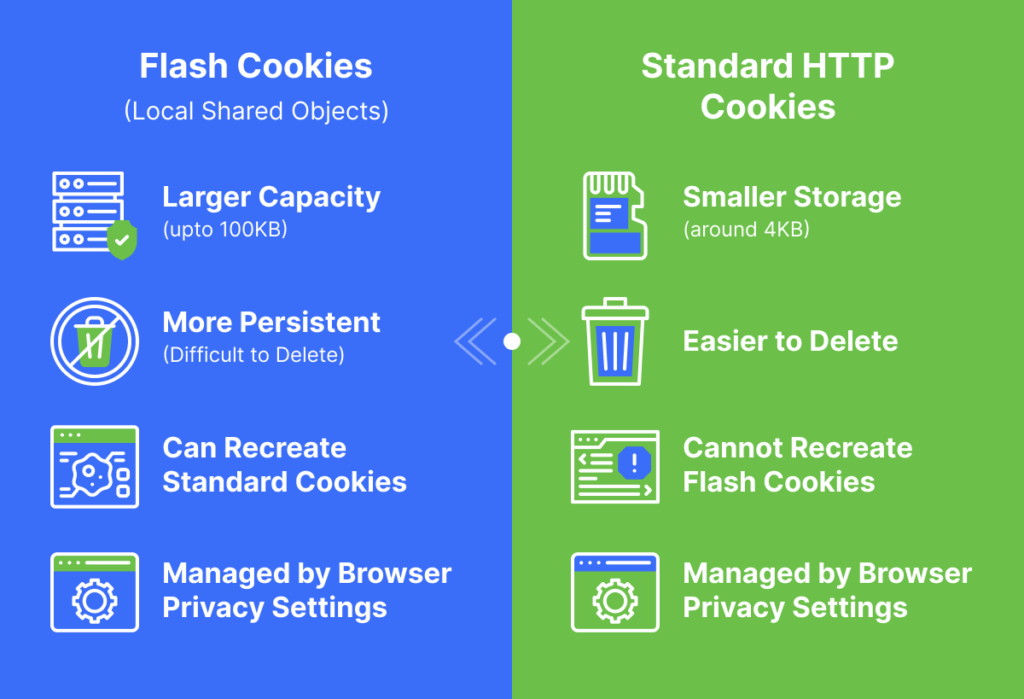Imagine tracking a visitor across multiple sessions—even after they’ve cleared their cookies—without their knowledge or consent. For years, this was the norm, driven by a tracking method called Flash cookies, which went largely unquestioned in digital marketing.
This blog breaks down what Flash cookies were, how they functioned differently from regular cookies, the compliance challenges they triggered, and why businesses today must avoid similar blind spots in their data practices.
Continue reading to learn how Flash’s quiet overreach reshaped modern data compliance—and what your business must do to avoid repeating history.
Flash cookies, officially known as Local Shared Objects, are small data files stored on a user’s device via Adobe Flash Player. Unlike regular cookies that browsers manage, Flash cookies operate outside of standard browser settings, making them harder to detect.
The difference between flash cookies and regular cookies lies in their location and persistence. Flash cookies reside in a separate storage system tied to Flash Player, making them more resilient against deletion.
What set flash cookies vs other cookies apart was their behaviour. Flash cookies could store up to 100KB of data per domain, 25 times more than typical browser cookies at the time. They also bypassed normal cookie controls, often persisting even after manual deletion attempts.

Websites leaned toward Adobe Flash cookies because they offered:
They were particularly popular in streaming and gaming sites that required user settings and playback history to be retained.
Flash cookies were stored in a location separate from your regular browser. This made flash cookies and browser controls incompatible, allowing marketers to track users long after they believed they had opted out.
These persistent cookies became a form of supercookies—tracking mechanisms that outlived regular deletion practices. Many businesses unknowingly built customer profiles based on data that users thought they had erased.
One of the major issues was that typical browser methods couldn’t remove flash cookies. Users had to access specific Flash Player settings to disable or delete them, a process few understood or knew about.
This stealthy persistence clashed with rising user demands for control and transparency in data handling.
Even if a user managed to delete browser cookies, Flash technology often respawned them using locally stored data. This process, known as “re-spawning,” highlighted a key flash cookie privacy concern.
It undermined user decisions and created friction between businesses and consumers who began demanding real control over their digital footprint.
Despite evolving privacy expectations, how websites use flash cookies often runs counter to user intent. Even businesses unaware of Flash’s deep storage could unknowingly breach trust by allowing tracking scripts to repopulate data.
This practice quietly ignored the principles of consent by design, laying the groundwork for today’s regulatory frameworks.
The backlash eventually triggered legal action. In the U.S., companies like Hulu and Clearspring were sued for using Flash cookies to recreate deleted browser cookies. These cases brought flash cookie compliance to the forefront.
Regulators and courts began interpreting stealth tracking as deceptive practices, paving the way for stricter enforcement in both the U.S. and the UK.
During the early 2010s, most websites did not explicitly include Adobe Flash content or storage disclosures in their privacy policies. This lack of transparency widened the compliance gap and exposed businesses to regulatory risks.
Failing to acknowledge flash cookies storage not only violated user trust but also conflicted with growing legal standards around data collection.
As privacy regulations evolved, Flash technology failed to adapt. It did not align with modern compliance requirements, such as GDPR, which mandates clarity around all data collection methods, including flash cookies GDPR concerns.
The opacity of Flash’s storage system made it difficult to audit or explain to users, putting businesses at odds with data protection laws.
Modern platforms emphasise user consent by design, where users must be informed and empowered to control data collection. Flash’s structure made that impossible. Its tracking often operated silently, bypassing user interaction and visible controls.
This incompatibility contributed to the overall decline of Flash as a trusted technology in digital marketing and analytics.
Flash-based elements were invisible to search engines, affecting site indexing. This made content hosted on Flash platforms a poor performer in organic search rankings.
For businesses relying on digital visibility, the tradeoff between enhanced tracking and reduced discoverability was not worth it.
Using flash local shared objects for persistent user tracking seemed like a clever marketing shortcut. However, it led to:
These outcomes often outweighed any short-term performance benefits.
Adobe officially ended support for Flash in 2021, yet traces remain. Some older sites or outdated tools may still utilise persistent cookies tied to Flash infrastructure.
Businesses must regularly audit systems to disable flash cookies or remove dormant Flash-based tracking that could pose hidden compliance threats.
Legacy tracking that may still live on includes archived Flash content or third-party codebases that haven’t been fully updated. These remnants could still compromise privacy and violate updated compliance standards.
Routine data hygiene and compliance checks are essential for identifying and eliminating outdated practices.
The story of Flash highlights a critical lesson: just because technology allows something doesn’t mean it should be done. Businesses must balance innovation with ethical standards in data collection.
Today, solutions like AI-powered CMPs (Consent Management Platforms) make it easier to maintain transparency. These tools help businesses manage consent across cookies, local storage, and other tracking technologies without falling into the traps of the past.
Whether you’re wondering are flash cookies still used or looking to modernise your consent strategies, tools built with compliance in mind can future-proof your business.
Take control of tracking and compliance with Seers AI. Our AI-powered CMP helps your business manage cookie consent, automate compliance, and build user trust—without the complexity. Start your smarter consent journey today.
Start Free NowFlash cookies were stored separately from browser cookies, typically within Adobe Flash Player’s storage directories. Unlike standard browser cookies, they didn’t show up in cookie managers or respond to traditional clearing methods. Users needed to access Flash Player settings manually to view or delete them, making detection and control difficult for the average user.
No, flash cookies are largely obsolete today. Adobe discontinued Flash Player in 2021, and major browsers no longer support it. However, remnants of Flash code or archived content on older websites might still carry outdated tracking mechanisms. Businesses should regularly audit legacy systems to ensure they’re not unintentionally using deprecated tracking tools.
Zero-party data is more accurate because it’s shared directly by users, based on their preferences and intent. Third-party data, in contrast, is often purchased or inferred, lacks context, and may be outdated or non-compliant. With growing privacy regulations and cookie deprecation, marketers benefit more from declared, permission-based data than from unreliable third-party sources.
Several companies faced lawsuits for using flash cookies to “respawn” deleted browser cookies. Notably, Hulu and Clearspring were involved in class-action suits in the U.S. These companies used Flash storage to rebuild tracking data without user consent, leading to legal consequences and broader public awareness around hidden tracking practices.
Users had to visit the Adobe Flash Player Settings Manager, often found online, to manage or delete flash cookies. This process involved navigating complex menus that weren’t user-friendly. Unlike browser cookie settings, these controls were obscure, making it difficult for most users to locate and clear stored Local Shared Objects (LSOs).
Yes, aside from privacy concerns, flash cookies and Flash-based content were often targets for malware and exploits. The architecture of Flash allowed for vulnerabilities that could be used to run malicious scripts or gain unauthorised access to user systems. This dual threat of privacy and security risk contributed to Flash’s eventual phase-out.
Modern tracking uses browser cookies, HTML5 local storage, fingerprinting techniques, and consent-based tools. Unlike flash cookies, most current methods are designed to comply with data protection laws like GDPR and CCPA. Consent management platforms, server-side tagging, and anonymised analytics are now standard for businesses focused on ethical and legal data collection.
 Rimsha Zafar
Rimsha ZafarRimsha is a Senior Content Writer at Seers AI with over 5 years of experience in advanced technologies and AI-driven tools. Her expertise as a research analyst shapes clear, thoughtful insights into responsible data use, trust, and future-facing technologies.


United Kingdom
24 Holborn Viaduct
London, EC1A 2BN
Get our monthly newsletter with insightful blogs and industry news
By clicking “Subcribe” I agree Terms and Conditions

Seers Group © 2025 All Rights Reserved
Terms of use | Privacy policy | Cookie Policy | Sitemap | Do Not Sell or Share My Personal Information.